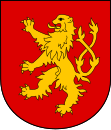Rousínov
| Rousínov | ||||
|---|---|---|---|---|
|
||||
| Basic data | ||||
| State : |
|
|||
| Region : | Jihomoravský kraj | |||
| District : | Vyškov | |||
| Area : | 2304 ha | |||
| Geographic location : | 49 ° 12 ' N , 16 ° 53' E | |||
| Height: | 241 m nm | |||
| Residents : | 5,673 (Jan 1, 2019) | |||
| Postal code : | 683 01 | |||
| License plate : | B. | |||
| traffic | ||||
| Street: | D1 Brno - Vyškov | |||
| Railway connection: | Brno – Přerov | |||
| Next international airport : | Brno Airport | |||
| structure | ||||
| Status: | city | |||
| Districts: | 7th | |||
| administration | ||||
| Mayor : | František Havíř (as of 2008) | |||
| Address: | Sušilovo nám. 84/56 683 01 Rousínov |
|||
| Municipality number: | 593559 | |||
| Website : | www.rousinov.cz | |||
| Location of Rousínov in the Vyškov district | ||||

|
||||
Rousínov (until 1921 Nový Rousínov , German Neu Raußnitz ) is a city in the Czech Republic . It is located twenty kilometers east of the city center of Brno and belongs to the Okres Vyškov .
geography
Rousínov is located south of the Drahan Mountains on the right side of the Rakovec river. The D1 / E 462 motorway runs south of the city .
Neighboring towns are Kralovopolske Vážany and Habrovany in the north, Komořany and Podbřežice in the Northeast, Čechyně the east, Kroužek the southeast, Rousínovec and Slavkov u Brna in the south, Slavíkovice , Velešovice and Holubice in the southwest, Kovalovice and Viničné Šumice the west and Vítovice in the northwest.
history
The first written mention of the place took place in 1222, when a Petrus de Russinow was listed as a witness in a document by Vladislav Heinrichs and Ottokar I. Přemysl . It is assumed that the later Starý Rousínov ( Rousínovec ) is meant by this.
The village of Nový Rousínov, located north of it on the trade route from Brno to Olomouc , is likely to have arisen in connection with a toll station that can be traced back to 1321. At that time the place belonged to the margravial castle of Spielberg . After Johann von Luxemburg lifted the compulsory route for merchants from Vienna via Mönitz to Brno in 1333 , the place profited from the increasing trade. During this time Nový Rousínov was raised to the status of a town with Měnín law. In 1350 the city was given the Brno law by Johann von Luxemburg. During the 15th century, the Hussites passed through Nový Rousínov, and in the Bohemian-Hungarian War there were again looting by troops passing through. When the Moravian Estates bought the Spielberg fortress from Emperor Ferdinand I in 1559 , they also acquired Nový Rousínov. As early as 1560, the stalls sold the town to Wilhelm Dubčanský. The royal city thus became a media city. In the map of the margraviate of Moravia created by Paul Fabricius in 1569 , Neu Raußnitz is shown as a fortified town. In 1593 Ulrich von Kaunitz acquired the town and added it to the Austerlitz rule . During the Thirty Years' War the population was harassed by various warring factions. In 1805 the Napoleonic troops moved through Neu Raußnitz on their way to the Battle of Austerlitz .
After the abolition of patrimonial New Raußnitz / Nový Rousínov formed a municipality in the Vyškov district from 1850 . There was a strong Jewish community in the city, which also formed its own political community. With the construction of the northern line from Brno to Sternberg , Neu Raußnitz, which was the last stretch before Brno, lost its importance in the 1870s. The number of carts decreased and the transports were shifted to the rails. During this time the city developed into a center of furniture manufacturing. This was initially done by hand in carpentry businesses, which gradually merged into factories. In 1900 there were 1615 people living in the city.
In 1921 the city's Czech name was changed to Rousínov. Founded in 1920, Spojené UP závody as Brno ( Vereinigte UP Werke AG Brno ) became the largest furniture manufacturer in Central Europe in the 1930s. In 1937 the company had 1,700 employees. In Neu Raußnitz there was a vocational school for the furniture industry.
The largest company with 500 employees is the furniture manufacturer Tusculum as
City structure
The town of Rousínov consists of the districts Čechyně ( Czechs ), Královopolské Vážany ( Königsfeld Waschan ), Kroužek ( Ringelsdorf ), Rousínov ( New Raußnitz ), Rousínovec ( Old Raußnitz ), Slavíkovice ( Lakowitz ) and Vítovice ( Wittowitz ).
Town twinning
- Dervio , Italy, since 2005
- Halásztelek , Hungary, since 2003
- Podbranč , Slovakia, since 2005
sons and daughters of the town
- Nikolai Dmitrijewitsch Braschman (1796–1866), Austro-Russian mathematician
- František Sušil (1804–1868), Moravian educator and folk song collector
- Franz Joseph Pisko (1827–1888), Austrian physicist
- Moritz Jellinek (1829–1914), 1848 revolutionary, doctor
- Rosa Barach (1840–1913), Austrian novelist, pedagogue, journalist
- Siegfried Reiter (1863–1943), philologist
- Radek Suchomel (* 1976), European champion and vice world champion in bodybuilding 2000
Attractions
- Former synagogue , built in 1591, today Hussite church
- Jewish Cemetery
- František Sušil's birth house
- Monument to Joseph II's personal furrow from 1769, erected at Slavíkovice station in 1895
- Baroque town hall, built at the beginning of the 18th century
- Statue of St. John of Nepomuk, on the market, built in 1772
- Parish Church of St. Wenceslas in Rousínovec, built between 1718 and 1734
- Branch church of St. Maria Magdalena in Rousínov, built between 1696 and 1717, on the market square
- Chapel of St. Florian



